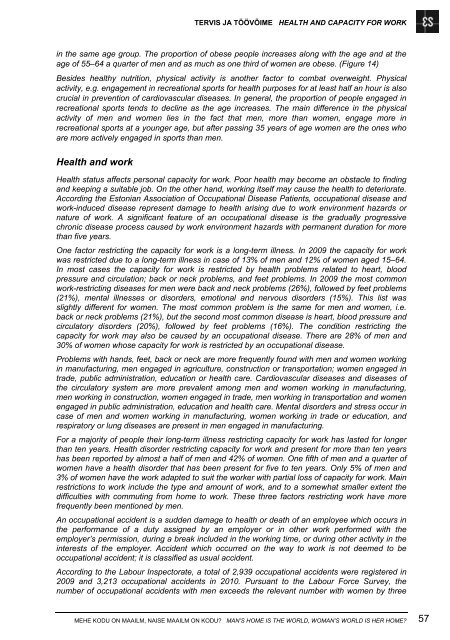MEHE KODU ON MAAILM, NAISE MAAILM ON KODU? - Tartu Ãlikool
MEHE KODU ON MAAILM, NAISE MAAILM ON KODU? - Tartu Ãlikool
MEHE KODU ON MAAILM, NAISE MAAILM ON KODU? - Tartu Ãlikool
You also want an ePaper? Increase the reach of your titles
YUMPU automatically turns print PDFs into web optimized ePapers that Google loves.
TERVIS JA TÖÖVÕIME HEALTH AND CAPACITY FOR WORK<br />
in the same age group. The proportion of obese people increases along with the age and at the<br />
age of 55–64 a quarter of men and as much as one third of women are obese. (Figure 14)<br />
Besides healthy nutrition, physical activity is another factor to combat overweight. Physical<br />
activity, e.g. engagement in recreational sports for health purposes for at least half an hour is also<br />
crucial in prevention of cardiovascular diseases. In general, the proportion of people engaged in<br />
recreational sports tends to decline as the age increases. The main difference in the physical<br />
activity of men and women lies in the fact that men, more than women, engage more in<br />
recreational sports at a younger age, but after passing 35 years of age women are the ones who<br />
are more actively engaged in sports than men.<br />
Health and work<br />
Health status affects personal capacity for work. Poor health may become an obstacle to finding<br />
and keeping a suitable job. On the other hand, working itself may cause the health to deteriorate.<br />
According the Estonian Association of Occupational Disease Patients, occupational disease and<br />
work-induced disease represent damage to health arising due to work environment hazards or<br />
nature of work. A significant feature of an occupational disease is the gradually progressive<br />
chronic disease process caused by work environment hazards with permanent duration for more<br />
than five years.<br />
One factor restricting the capacity for work is a long-term illness. In 2009 the capacity for work<br />
was restricted due to a long-term illness in case of 13% of men and 12% of women aged 15–64.<br />
In most cases the capacity for work is restricted by health problems related to heart, blood<br />
pressure and circulation; back or neck problems, and feet problems. In 2009 the most common<br />
work-restricting diseases for men were back and neck problems (26%), followed by feet problems<br />
(21%), mental illnesses or disorders, emotional and nervous disorders (15%). This list was<br />
slightly different for women. The most common problem is the same for men and women, i.e.<br />
back or neck problems (21%), but the second most common disease is heart, blood pressure and<br />
circulatory disorders (20%), followed by feet problems (16%). The condition restricting the<br />
capacity for work may also be caused by an occupational disease. There are 28% of men and<br />
30% of women whose capacity for work is restricted by an occupational disease.<br />
Problems with hands, feet, back or neck are more frequently found with men and women working<br />
in manufacturing, men engaged in agriculture, construction or transportation; women engaged in<br />
trade, public administration, education or health care. Cardiovascular diseases and diseases of<br />
the circulatory system are more prevalent among men and women working in manufacturing,<br />
men working in construction, women engaged in trade, men working in transportation and women<br />
engaged in public administration, education and health care. Mental disorders and stress occur in<br />
case of men and women working in manufacturing, women working in trade or education, and<br />
respiratory or lung diseases are present in men engaged in manufacturing.<br />
For a majority of people their long-term illness restricting capacity for work has lasted for longer<br />
than ten years. Health disorder restricting capacity for work and present for more than ten years<br />
has been reported by almost a half of men and 42% of women. One fifth of men and a quarter of<br />
women have a health disorder that has been present for five to ten years. Only 5% of men and<br />
3% of women have the work adapted to suit the worker with partial loss of capacity for work. Main<br />
restrictions to work include the type and amount of work, and to a somewhat smaller extent the<br />
difficulties with commuting from home to work. These three factors restricting work have more<br />
frequently been mentioned by men.<br />
An occupational accident is a sudden damage to health or death of an employee which occurs in<br />
the performance of a duty assigned by an employer or in other work performed with the<br />
employer’s permission, during a break included in the working time, or during other activity in the<br />
interests of the employer. Accident which occurred on the way to work is not deemed to be<br />
occupational accident; it is classified as usual accident.<br />
According to the Labour Inspectorate, a total of 2,939 occupational accidents were registered in<br />
2009 and 3,213 occupational accidents in 2010. Pursuant to the Labour Force Survey, the<br />
number of occupational accidents with men exceeds the relevant number with women by three<br />
<strong>MEHE</strong> <strong>KODU</strong> <strong>ON</strong> <strong>MAAILM</strong>, <strong>NAISE</strong> <strong>MAAILM</strong> <strong>ON</strong> <strong>KODU</strong>? MAN’S HOME IS THE WORLD, WOMAN’S WORLD IS HER HOME? 57

















